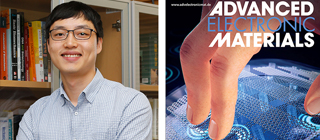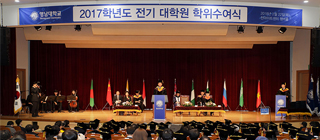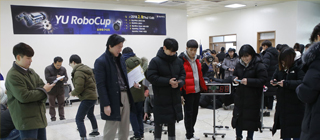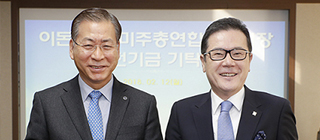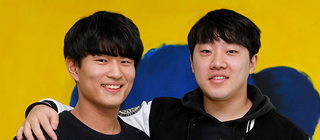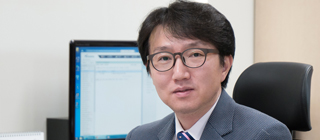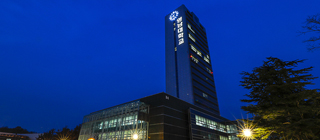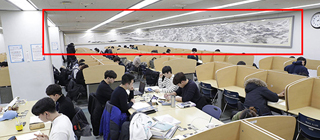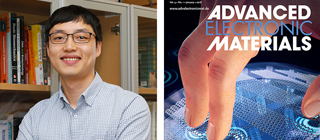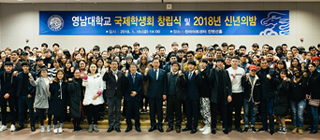-
Joint research by the research teams of YU Professor Choi Jung-wook and Yonsei University Professor Kim Jong-baek Production of transparent and flexible touch sensor that accurately recognizes the location and size of multiple pressures Published on the cover of the latest SCI academic journal in the new materials field [February 1, 2018] <Cover of the academic journal ‘Advanced Electronic Materials’ (right) in which the research paper of School of Mechanical Engineering Professor Choi Jung-wook (left) was published as the cover paper> YU School of Mechanical Engineering Professor Choi Jung-wook (34) succeeded in developing a highly sensitive touch sensor that could be applied in multiple touch screens and next-generation wearable devices. With the recent growth in interest on Internet of Things (IoT), there has been an increase in demand for various sensor technologies. In particular, research on touch sensors are being actively carried out to be used in next-generation wearable devices and touch screens used in mobile phones, tablet PCs, etc. In this research conducted jointly with Professor Kim Jong-baek’s team from Yonsei University, Professor Choi developed a transparent and flexible sensor that can measure pressure from various points. Unlike multi-touch sensors of the past, it can recognize the size and location of pressures applied in various points precisely. Professor Choi explained, “In past research, electrodes, which are the main components of touch sensors, were made of non-transparent or easily breaking materials such as metals or indium oxide compounds, making it difficult to use for flexible sensors. In addition, it is necessary to measure the size and location of pressure applied for ideal multi-touch sensor recognition, and existing studies usually focus on improving sensitivity.” He added, “There was no research on transparent and flexible touch sensors that could accurately measure the location where pressure is applied. This study successfully produced transparent and flexible touch sensors using graphene electrode array integrated into the plastic board.” The research results were published as the cover paper of the latest issue (Jan 10, 2018) of the globally acclaimed academic journal in the new material sector <Advanced Electronic Materials, (Impact Factor (IF) 4.193)>. Professor Choi stated, “The sensor developed here is expected to be used not only in multi-touch screens, but also in wearable devices that are receiving attention as next-generation electronic devices. In addition, the entire production process of the sensor is done in a single process, so it has very high productivity and yield, and it will help with the distribution of practical elements based on carbon nano-materials.” Professor Choi acquired his PhD in mechanical engineering at Yonsei University and completed his post-doctorate at Purdue University and has been serving as a professor at YU since 2016. His main field of research is micro and nano-electrical/mechanical systems, and his research mainly deals with ultra-small energy conversion materials using nano-materials, wearable electronic devices, sensors, and nano-compounds, etc.
-
Graduation ceremony for general graduate schools held at the Cheonma Art Center Chamber Hall at 10:30 a.m. on the 22nd 82 PhD, 571 master’s and 3,833 bachelor degree diplomas given [February 22, 2018] YU (President Sur Gil-soo) held the 2017 graduate school graduation ceremony at the Cheonma Art Center Chamber Hall at 10:30 a.m. on the 22nd. The colleges and special graduate schools such as Law School, Business Administration, Public Administration, Environment & Public Health Studies, Sports Science, Clinical Pharmacology, Education, Engineering, Arts & Design, and Park Chung Hee School of Policy and Saemaul also held graduation ceremonies. On this day, 3,833 received their bachelor’s degree, 571 master’s degree, and 82 PhDs at YU. YU President Sur Gil-soo, Dean of Graduate School Lee Tae-jin, and Yeungnam School Foundation President Han Jae-sook attended the graduation ceremony to hand over the diplomas and congratulate students on their graduations. During his congratulatory address, YU President Sur Gil-soo said, “I would like to congratulate the graduates who worked hard for several years and received their honorable degrees.” He added, “Those who have graduated today are now lining up for a new beginning. I am confident that you will be the leaders of the future of Korea instilled with a sense of pride as alumni of YU and a grave sense of responsibility. I ask that you confidently embark on the path you desire with passion and ambition.” At this graduation ceremony, Mrs. Kim Young-ja became the oldest person to receive her diploma by receiving her bachelor’s in business after commuting between Goesan, Chungbuk and YU for four years. Also, 179 international students (26 bachelor’s, 125 master’s, 28 PhD’s) received their diplomas and 416 undergraduate school students received multiple diplomas of two or more.
-
72 people in 24 teams from 7 schools (departments) of the College of Mechanical and IT Engineering participated Produce and operate ‘balancing robots’ integrating mechanics, electronics, electric, software, and wireless communication technologies ‘Nurturing convergence/integration capacities for the 4th industrial revolution’ [February 8, 2018] YU (President Sur Gil-soo) held the soccer tournament, ‘YU RoboCup’. This tournament, which was supervised by the YU Robot Project Team, was held at the Robot Hall lobby at 1 p.m. on the 8th. A total of 72 students in 24 from seven schools (departments) of the YU College of Mechanical and IT Engineering that is participating in the PRIME Project participated. The participating students teamed up into groups of three and competed in a 3 on 3 robot soccer tournament. Each match was comprised of two five-minute halves for a total of 10 minutes, and teams that were disqualified in the tournament participated in the ‘Robot Maze Finding’ competition. The ‘YU RoboCup’ that YU held for the first time this year is a robot soccer tournament using ‘balancing robots’ that have two wheels. Students make their own balancing robots by integrating mechanical, electronic, electric, software and wireless communication technologies. To help develop capacities of students and for the smooth progress of the tournament, YU offers pre-training on how to assemble robot kits, code software, and on wireless communications. YU President Sur Gil-soo said, “By having students make and operate balancing robots that integrate various disciplines and IT technologies will help improve their problem-solving skills in technology convergence.” He added, “YU will develop various curricula and programs so that students can gain inter-disciplinary capacities and practical knowledge for the oncoming fourth industrial revolution.” Meanwhile, YU established the College of Mechanical and IT Engineering in 2017 as part of the Ministry of Education’s ‘Program for Industrial Needs – Matched Education’. YU separated the electric, electronics, computer, information communication, and mechanics majors in its College of Engineering to establish the College of Mechanical and IT Engineering, while newly establishing the Department of Robotics and Intelligent Machine Engineering and Department of Automotive Engineering. in addition to the mechanics, electric, electronics and computer sectors that YU maintained a strong tradition in, it is also focusing on fostering intelligent robots and future automobiles fields, which are future new growth engines.
-
Another million dollar donation after a million dollar donation in 2012... Donated a total of 2 million dollars in the ‘Weolsan Scholarship Foundation’ Started Active U.S.A Inc. that has become the top in the LA clothing and fashion market Strong love to alma mater and juniors at YU... Led the founding of the YU Alumni Association in the US and served as its first chairperson YU gives ‘Proud YU Award’ and ‘Honorary Doctorates Degree in Business Administration’ [February 12, 2018] Don Lee (64), the chairperson of Active U.S.A. Inc., a clothing giant based in LA, visited his alma mater at YU (President Sur Gil-soo) on February 12 and donated one million dollars. He also made a million dollar donation in 2012 to the ‘Weolsan Scholarship Foundation’ and donated an additional million dollars for a total of two million dollars. The ‘Weolsan Scholarship Foundation’ is a scholarship fund under the name of his mother Lee Hong-shik and was named Weolsan after the nom de plume of his father, Weolsan Lee Dong-ho. Chairman Lee said, “Despite living through the desperate times of the Japanese Occupation and the Korean War, my parents practiced filial piety to their ancestors and always lived a life of love, devotion and sacrifice for the education of their children. My father past away in July 2011 and at the one year anniversary of his passing, I decided in 2012 to donate scholarships under the names of his late father and mother to honor them.” YU chose three students as full-time scholarship students until now, but is planning to expand it to up to seven students by 2019. President Sur Gil-soo said, “Students of YU should feel proud of the through of having a senior who is always thinking of and supporting YU and its students even in faraway countries.” He added, “We will honor the will of Weolsan Lee Dong-ho who devoted his life to the education of his children. YU will provide full support so that students at YU can become global leaders like Chairman Don Lee.” Chairman Lee entered the YU Department of Architectural Engineering in 1973. After graduating, he joined Samhwan Corporation and Kolon Construction and worked at construction sites in the Middle East. In 1985, he moved to the United States and founded Active U.S.A. Inc. and business went well. In 1992, however, during the LA riots, he lost all of his belongings, but then came back. He is currently serving as the chairperson of the San Pedro Fashion Mart Association, Director of Pacific Bank, which is a Korean bank in the US, World Korean Business Convention Leading CEO, director of the Hoeje Lee Eon-jeok Memorial Association, director at the LA Chamber of Commerce, 3rd person of the Overseas Honor Society, and overseas advisor of Gyeongsangbuk-do. Even before making donations to the Weolsan Scholarship Foundation, Mr. Lee continuously gave support for the development of his alma mater. Mr. Lee initiated the founding of the YU General Alumni Association in the US for the first time for a Korean university outside of the Seoul area and served as its first chairman. He also took the position of the scholarship foundation chairperson of the US Alumni Association to give scholarships to YU students studying abroad, which numbered to over 30 students. He also invited over 100 YU students as interns for Active U.S.A. up until now to help improve the work capacities of his juniors, while offering education on advanced technologies and business management to help give them an edge in gaining employment in Korean companies. He also donated 100 million won for the construction of the Cheonma Art Center to celebrate the 60th year anniversary of YU and donated the most amount of the 230,000 alumni in the YU General Alumni Association Scholarship Foundation. In order to honor Chairman Don Lee’s contributions, YU awarded Mr. Lee with the ‘Proud YU’ award in 2006 and gave him an ‘honorary doctorate’s degree in business administration’ in 2014.
-
YU students get rid of the typical open space by dividing zones and even making space for those who wish to eat alone Transformation to ‘Mokoji’, a cultural campus space for relaxation and rest Received ‘Grand Prize’ in ‘Samsung Well-Story’ contest specializing in eating out [February 5, 2018] <Student cafeteria brand ‘Mokoji’ designed by YU students> (Grand prize in the Samsung Well-Story contest) YU students recently received attention by designing a student cafeteria reflecting the lifestyles and trends of college students. The most common image of student cafeterias in college campuses is a large open and loud space. Students have different class schedules and various study and group activities. There are also many college students who prefer personal lifestyles not interrupted by other people. Unfortunately, however, most student cafeterias are designed similarly to the cafeterias of companies where employees all eat together at the same time. There were only the slightest of changes in most student cafeterias for decades. There are college students who integrated new designs and concepts into such student cafeterias. They are Kim Yong-joon (24, left on photo, Department of Food Service Industry), Kim Young-gun (23, Department of Food Service Industry, junior), Ha Dong-woo (24, junior at the School of Materials Science and Engineering, right on photo), and Choi Yu-jin (21, sophomore at the Department of Industrial Design). They gave birth to the food and drink space brand ‘Mokoji’ (Korean word meaning many people gathering in one place’) that can house the stories of students. Kim Yong-joon, who majors in the Food Service Industry’, said, “We made separate spaces where students can enjoy meals during lunch time when most students come to eat and be able to feel relaxed to chat and spend time. It was designed also taking into consideration those who eat alone, which has recently become a kind of a trend.” ‘Mokoji’ created a partitioned structure so that students can come together to communicate, while also allowing those who wish to spend time alone without having to worry about what others think in its cafeteria design. Ha Dong-woo said, “Another concept of ‘Mokoji’ is the efficient use of personal time at the cafeteria. We aimed at allowing students to be able to come to ‘Mokoji’, regardless of the time for meals, to hold meetings, talk with friends, or concentrate on assignments alone.” He added, “By creating a space where students can feel free to visit at any time, it will be possible to transform the cafeteria into a place that contains the campus culture.” Meanwhile, this idea by YU students also caught the attention of Samsung Well-Story, which specializes in food service businesses. ‘Mokoji’ won the grand prize in the contest for college students under the theme ‘coordinate student cafeterias into a new space for food and beverages’ in December of last year. Samsung Well-Story is planning to review the winning pieces and reflect them in student cafeterias that are being currently operated.
-
Research on computer system principles, theories, and practical configuration Excellent research achievements in non-volatile memory and storage sectors Published over 10 SCI theses in past five years and published over 20 theses in domestic and foreign academic conferences [January 22, 2018] YU Department of Computer Engineering Kwak Jong-wook (42, photo) received the academic award at the Korean Society of Computer and Information winter academic conference held at the Kyungnam College of Information & Technology from the 11th to the 13th. Professor Kwak was recognized for his latest research in non-volatile memory and storage and his academic activities in high performance computing and embedded systems. Professor Kwak mainly focuses on research in next-generation computer system principles, theories and practical configuration. Based on academic disciplines in computer structures and operating systems, he is conducting research on high performance processor design, cache memory and flash memory configuration, mobile embedded systems, and cloud computing. He recently made outstanding research achievements in non-volatile computer memory and storage that maintains information even if power is disconnected for next-generation memory that will replace DRAM. Professor Kwak was awarded for his papers a total of seven times including the excellent thesis award in 2016 by the Korean Society of Computer and Information, excellent thesis award in 2015 by the Korean Institute of Industrial Engineers, and other computer and IT societies. Furthermore, he recently published over 10 papers in SCI journals over the past five years and presented over 20 theses in domestic and foreign academic conferences, continuing his research activities. Professor Kwak has been serving as a professor at the YU Department of Computer Engineering since September 2007 and was the director of the YU DREAM Software Human Resources Fostering Team. He is also currently the chairman and editing member for theses of the Korean Society of Computer and Information High Performance Computing Academic Subdivision as well as an editing member for theses of the Korean Institute of Communications and Information Sciences. In addition, Professor Kwak is also concentrating on improving education such as winning the excellent lecturer award at YU in 2015.
-
Large clock installed on the outer wall of the central library 80m high Alumnus Choi Hyuk-young (Civil Engineering ’63) paid for entire cost of installation, “I hope my juniors will become leaders of the future” Juniors respond by naming it in honor of their senior, ‘Hopes for development of YU’ [January 29, 2018] <‘Big Time’ installed on the outer wall of the YU central library> A new landmark representing the region now stands tall at the YU (President Sur Gil-soo) campus. YU installed ‘Big Time’, a large clock on the upper part of the outer wall of the central library at about 80m high. ‘Big Time’ is a round clock with a diameter of 6m and is comprised of an hour and minute hand. It is equipped with a GPS that automatically calibrates the time every day at midnight. The time and needles have LED lights that illuminate extravagantly even in the night. It is high enough to be seen clearly from far outside of the campus, and it is large enough to capture the attention of people passing YU. The YU central library was built with 22 stories in November 1974, making it a towering skyscraper at the time. It acted as the local landmark since then. After large-scale renovations in 2005, the ‘Big Time’ was finally installed, once again receiving attention as the main landmark of the region. ’Big Ben’, which is one of the world’s most famous clock towers in the world located in London, England, has a height of 96m and Hong Kong’s land mark ‘Tsim Sha Tsui Clock Tower’ is 44m tall. YU’s ‘Big Time’ that stands 80m is world-class in terms of height. <<Choi Hyuk-young Scholarship Foundation President Choi Hyuk-young who donated the entire amount for installing ‘Big Time’ (right)> ’Big Time’ that was installed was paid for in full by Choi Hyuk-young Scholarship Foundation President Choi Hyuk-young (75), who was in the class of ‘63 at the YU Department of Civil Engineering. Mr. Choi said, “I wanted to give a gift in hopes of my juniors at YU to become leaders of the future.” He added, “I hope that the students look at the clock standing at the highest place in the YU campus to dream big and continue studying hard so that they may become leaders of Korea.” YU students responded with the generous gift of their senior’s love by naming the clock tower. ‘Big Time’, which was named by YU students, means not only a big clock that represents YU, but also ‘huge success’. It contains the hopes of their YU seniors that YU may continue to develop further. Mr. Choi has been sharing generously with YU and his juniors at YU not only with ‘Big Time’, but also through continuous scholarships by establishing the Choi Hyuk-young Scholarship Foundation. YU President Sur Gil-soo said, “I hope that students will look at Big Time, which has become the new landmark of YU, to remember the will of their senior YU alma mater Choi Hyuk-young,” while adding, “I hope like the meaning of becoming a big-timer, students will have the opportunity to dream big at the YU campus.” Meanwhile, the ‘Big Time’ opening ceremony was held in the afternoon of the 26th at YU. Mr. Choi who funded the ‘Big Time’ attended the ceremony to congratulate the start of the clicking of Big Time.
-
Painting by Min Gyeong-gap, texts by Lee Eun-sang, calligraphy by Kim Chung-hyun Joint ink-and-wash painting by three famous artists in 1970 YU president recently shed light on this and decided to restore the original <akdonggang Cheollido (inside red frame) hung at the reading room at B1 of the YU central library [Photo YU]> In the afternoon of the 22nd at the B1 reading room of the YU central library in Gyeongsan, Gyeongbuk. There is a 24m long by 1m wide painting behind students hitting their books. The painting was so long that it could not be hung on just one wall, but had to be divided and hung on two sides of the wall. It is an ink-and-wash painting that descriptively painted Nakdonggang (Riv.) and the surrounding mountains. The painting is housed in a frame. However, dust is visible on it and the state of preservation is not very good. If you look closely at the painting, you can see three names who are the authors of this painting. It says, ‘March 1, 1970’ in letters painted with a brush, and also says ‘Painting by Yusan Min Gyeong-gap’, ‘Text by Nosan Lee Eun-sang’ and ‘Calligraphy by Iljun Kim Chung-hyun’. This is ‘Nakdonggang Cheollido’ that was painted by the most famous eastern painter, poet and calligrapher in 1970 by traveling across Nakdonggang (Riv.) on a helicopter. It is reported to be the biggest ink-and-wash painting collaboration, but it is also famous as a painting made up of more than 2.5 million brush strokes. Yusan Min Gyeong-gap (85) is an East Asian painter who painted ‘Jangseng’ that is hung on the reception room of the Cheonwadae. He also served as the chairman of the National Academy of Arts. Nosan Lee Eun-sang (1903-1982) is a poet who wrote poems such as Gagopa, Thinking of Home, Night at Seongbulsa Temple. Iljung Kim Chung-hyun (1921-2006) was Korea’s top calligrapher who also served as the president of the Korea Calligrapher Association. Basically, Korea’s first priceless collaboration painting from 50 years ago is hanging on the wall in the basement reading room. What happened? The story goes back to 1970. According to personnel from YU, President Park Chung-hee said he wanted to give a gift in commemoration of the third anniversary of YU in 1967. He came up with the idea of the Nakdonggang Cheollido. The Nakdonggang Cheollido was completed by the greatest artists of the time and bestowed to YU where it was hung at the library in Daemyeong-dong in Daegu, where the campus was formerly located. Time passed and people lost interest. Around 2005, the painting was moved to its current location at the reading room in the basement of the central library in Gyeongsan. YU President Sur Gil-soo recently shed light on the Nakdonggang Cheollido that was hung in the basement reading room. YU President Sur said, “My acquaintances at YU from the past such as National Assemblyman Joo Ho-young asked about the Nakdonggang Cheollido. I asked around and found that it was hung folded.” He added, “As this painting is a national heritage, we will utilize it as a symbol that represents the school. YU organized a steering committee on the 22nd and decided to bring the Nakdonggang Cheollido outside of the reading room for management. They will soon make a photo-print of the painting and hang it at the entrance of the Cheonma Art Center, which is the school’s performing venue. The original will be restored and be stored at the YU Museum archives.
-
YU Professor Choi Jung-wook – Yonsei University Professor Kim Jong-baek teams up for joint research Produced transparent and flexible touch sensor that can precisely detect the location and size of multi-pressure Published on cover of the latest issue of SCI academic journal in the new materials sector [February 1, 2018] <School of Mechanical Engineering Professor Choi Jung-wook’s (left) thesis was published on the cover of the academic journal 'Advanced Electronic Materials' (right)> YU School of Mechanical Engineering Professor Choi Jung-wook (34) succeeded in developing a highly sensitive touch sensor that can be applied in multi touch screens and next-generation wearable displays. With the recently high interest in Internet of Things (IoT), there has been a growing demand for various sensor technologies. In particular, there is active research going on for touch sensors to be used in touch screens for mobile phones, tablet PCs, etc. as well as for use in wearable displays. Professor Choi teamed up with Yonsei University Professor Kim Jong-baek’s research team to develop a transparent and flexible touch sensor that can measure pressure from various points. Unlike other multi-touch sensors, it can detect size and location of pressure precisely as soon as the pressure is applied in multiple points. Professor Choi said, “In past research, the electrode, which is an important element of the touch sensor, was comprised of non-transparent and easily breaking materials such as metals and indium oxide, so there were limitations in using them as flexible sensors in reality. In addition, it is necessary to be able to accurately measure the size and location of pressure being applied for ideal multi touch recognition, but most research in the past focused on improving sensitivity.” He went on saying, “There were no studies conducted on transparent and flexible touch sensors that can measure the exact location where pressure was applied. In this research, we succeeded in producing transparent and flexible touch sensors using graphene electrode arrays integrated with plastic boards.” The results of this study was carried on the cover of the latest issue (January 10, 2018) of the globally acclaimed academic journal in the new materials sectors, <Advanced Electronics Materials (impact factor (IF)) 4.193). Professor Choi stated, “I believe that the sensor that we developed will be applied not only in multi-touch screens, but also in wearable displays that are receiving attention as next-generation electronic devices. In addition, as the entire production process of the sensor is made in a single process, it has very high productivity and yield, so it will help with carbon nano material-based practical element distribution. Professor Choi earned his PhD in mechanical engineering at Yonsei University and completed his post-doctorate at Purdue University in the United States, and began working as a professor at YU since 2016. His major field of research is micro and nano electro-mechanical systems, and he mainly conducts research on micro energy transformation elements and wearable electronic devices using nano materials, sensors and nano compounds.
-
Systematic support from the college for academics and settlement for international students Expected to attract more foreign students by improving satisfaction on studying in Korea Utilize as window for communication between university and international students, exchange information between international students, and be a place for networking [January 24, 2018] <Launching ceremony of the YU International Student Association> YU (President Sur Gil-soo) established the ‘International Student Association’. Its purpose is to help international students adapt to life in Korea quickly and to provide systematic support by the university for adapting to school life. On the 19th, YU held the launching ceremony of the International Student Association at the Convention Hall on the third floor of the Cheonma Art Center with the attendance of YU Presiden Sur Gil-soo, international student support team, and over 300 international students studying at YU. Until now, international students at YU independently organized international student associations within their colleges and operated communities for their respective countries. Currently, there are approximately 1,340 international students from 65 countries studying at YU in undergraduate school and graduate school, and at the Korean Language School. By establishing the YU International Student Association as an official organization, it appears that it will help to not only motivate the academic performance and adapting to life in Korea for international students, but also be used for networking for international students from various countries to share information. In particular, it is expected that by improving satisfaction of studying abroad for international students, it will contribute in attracting more international students in the long term. At the launching ceremony, YU President Sur Gil-soo said, “YU is not holding back in supporting the stable settlement and academic work of international students by methods such as establishing Korea’s first global exchange center, which is a general support facility for international students.” He added, “I hope that the International Student Association will become a student-governing body and a window for communication between the university and international students by forming a community among international students.” The YU International Student Association is planning to organize academic departments, translation departments, legal consultation departments, culture and sports departments, and PR departments to help with student-governing activities, while also supporting the academic and everyday life of international students (experience-based learning, pick-up service upon arrival, academic and life consulting, etc.) through cooperation with the university. At the launching ceremony, Pan Yinchen (30, right on photo) from China currently enrolled at the YU Graduate School of Korean Language and Literature master’s degree program was appointed as the first chairperson of the association. Mr. Pan Yinchen who received the International Student Association flag from YU President Sur Gil-soo said, “I will help the International Student Association help international students settle down stably and focus on their studies.” He added, “I will also do my best so that we can help YU develop as not only international students, but members of YU.” Meanwhile, YU held a New Year’s event with international students together with the launching ceremony of the International Student Association. At this event, international students held Korean speaking contests and talent shows to celebrate the founding of the International Student Association.
